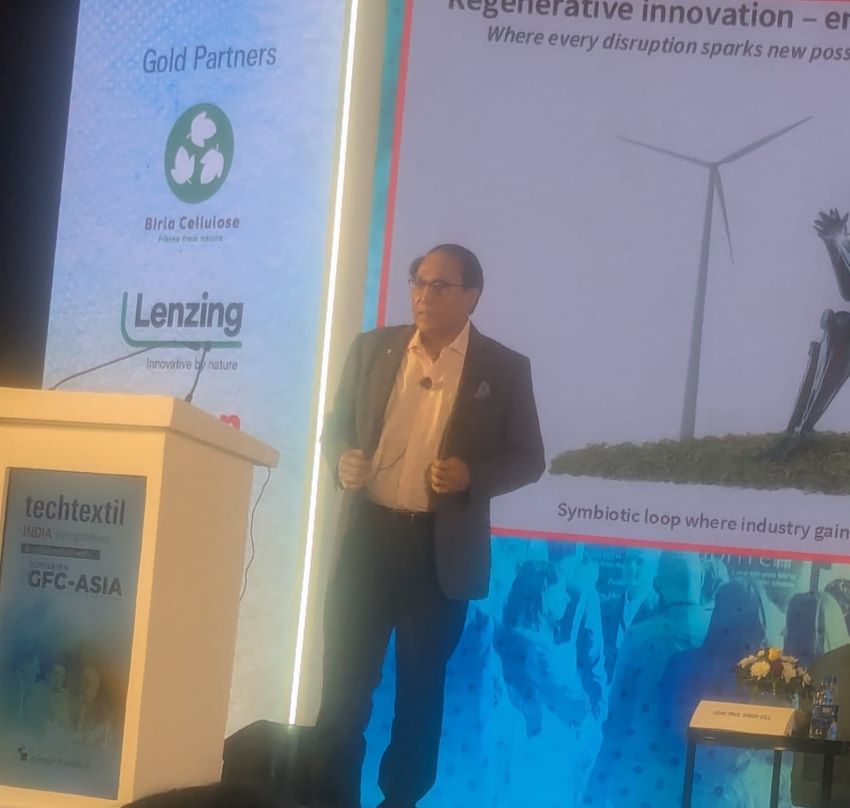FW
Apparel Textile Sourcing Canada (ATSC), will be held in Canada from August 21 to 23, 2017. This is the first Canadian trade show to be launched by an online B2B trade platform and is also the largest being held in the country. This is the second year of the show. The 2016 show had more than 200 booths of merchandise and more than 1800 attendees. Canadia’s import of clothing, textile and footwear touched an all-time high in 2016 at CAD$2.1 billion. With positive business sentiment, ATSC has increased 50 per cent exhibit space at Toronto’s International Centre for this year’s show.
The event connects Canada to the world players. It attracts to Canada hundreds of apparel and textile manufacturers from around the world including China, India, Bangladesh, Pakistan, the US, the UK, Mexico, Colombia, Peru and more. Through an impressive platform of seminars and sessions, attendees can make global industry connections, and gain the insights needed to navigate the international sourcing process.
New for 2017 will be a leading-edge trends showcase featuring the latest and greatest in apparel and textiles and a high-profile roster of international speakers. A fashion show and design contest will also be held, featuring items available to be sourced at the event, as well as fashions from local designers and students.
The growth of the Canadian market and its unique business opportunities are attractive to Chinese manufacturers. An increased number of high-quality Chinese producers will be seen at the 2017 show.
"Though a marginal increase, yet the entire textile industry is in support of the measures allotted by the FM Arun Jaitley in the Union Budget. Total budget allocation for the textile ministry is Rs 6,226.5 crores for fiscal 2017-18 against last year’s revised allocation of Rs 6,286.1 crores. Budgetary allocation for powerloom, silk and wool textile sectors have increased and handloom and handicraft sector were also allocated sizable amount of funds. Salient features include:"

Though a marginal increase, yet the entire textile industry is in support of the measures allotted by the FM Arun Jaitley in the Union Budget. Total budget allocation for the textile ministry is Rs 6,226.5 crores for fiscal 2017-18 against last year’s revised allocation of Rs 6,286.1 crores. Budgetary allocation for powerloom, silk and wool textile sectors have increased and handloom and handicraft sector were also allocated sizable amount of funds. Salient features include:
Technology upgradation support

Government’s flagship technology up-gradation scheme ATUFS receives an allocation is Rs 2,013 crores for 2017-18, which has been welcomed by the industry at large. Scheme for in situ upgradation of plain power looms received Rs 68.31 crores, which is a big boost form Rs 48 crores last year. Under this scheme, power loom owners would get support to upgrade weaving technology without replacing the whole loom.
Incentives to boost competitiveness, employment, skilling
Allocation under Remission of State Levies has increased sizably to Rs 1,555 crores. This scheme includes refund of state taxes to garments exporters to make the industry competitive and boost employment. Fund allocation under Pradhan Mantri Paridhan Rojgar Protsahan Yojna is Rs 200 crores. This new scheme provides the Employee Pension Scheme contribution of 8.33 per cent of the employers for all new employees enrolling in EPFO under PMRPY for the first three years of their employment. This will boost employment by incentivising employers and improving competitiveness. Integrated Scheme for Skill Development for the textile sector receives Rs 174 crores, which is operational for last several years for under skilled factory workers.
Additional measures
Basic custom duty on Nylon mono filament yarn (for use in long line system for Tuna fishing only) has been reduced to 5 per cent (from earlier 7.5 per cent). Textile and apparel industry would benefit from Trade Infrastructure Export Scheme (TIES) with an allocation of Rs 3.96 lakh crore. Higher income and spending by rural India will stimulate consumption of textiles and apparels.
Reduction of corporate tax by 5 per cent to MSME (turnover below Rs 50 crores) will benefit textile and apparel industry as majority of enterprises fall into this category. Further, additional allocation to banks for NPA accounts, cashless transaction, labour reforms and relaxation of FDI norms by abolishing Foreign Investment Promotion Board (FIPB) would also benefit the industry.
A positive Budget says industry
Prabhu Damodaran, Secretary, Indian Texpreneurs Federation says the Budget focuses on aggressive spending in infrastructure, which will reduce logistics expenses. Ajay Sahai, DG Federation of Indian Export Organisations, observes the Budget is a roadmap for textile sector. Infrastructural development will not only boost domestic textile market but also ease exports by reducing logistics costs. A new and restructured central scheme with a focus on export infrastructure, namely, Trade Infrastructure for Export Scheme has also been announced.
Ujwal Lahoti, Chairman, The Cotton Textiles Export Promotion Council (TEXPROCIL) welcomed the Budget and appealed to restore some of the incentives relating to interest subvention for merchant exporters and cotton yarn and MEIS benefit for cotton yarns. The job creating package for textile sector found a worthy mention in latest Economic Survey 2016-17. However, the made-ups sector which is included in the package still awaits the rates on ROSL scheme (Refund of State Levies). He said he hoped the rates will be announced soon so that the sector could take advantage of this path breaking scheme.
He further stated that the Economic Survey 2016-17 has expressed concern on Indian exporters of garments/textiles being disadvantaged on account of absence of Free Trade Agreements (FTAs). The Survey estimated an FTA with EU and UK can lead to almost 1 lakh additional jobs being created in the garment sector apart from an increase in exports of $2 billion. If fabrics and made-up industries are also included in this calculation, the exports can easily increase to $3.5 billion and an additional 1 million jobs can be created. With these FTAs taking time, government should immediately consider giving an additional benefit of 3 per cent MEIS for exports of made-ups to EU so that the adverse impact can be mitigated to some extent, till such time the FTA is signed.
M B Raghunath, President (Sales & Marketing), Mafatlal Industries welcomed the Budget and said the garment sector will get a boost on long term basis due to 35 per cent increase in government expenditures in Rural Infrastructure Development Rural investment and rural economic improvement will boost demand for textiles and garments. Small & medium scale textiles and garment manufacturing companies will benefit. Indirect taxes are not addressed by the FM because the same will be addressed at the time of GST implementation.
“An inclusive Budget with a clear focus on agriculture, infrastructure, digitization and employment generation. Medium and Small Enterprises (MSMEs) are the backbone of the industry and generate the maximum employment. Tax cut for the MSMEs with an annual turnover of Rs 50 crore is a welcome gesture and will drive the growth engine as most of India's companies will get this benefit of 5 per cent tax reduction which will be a relief for them,” says Deepak Chiripal, CEO, Nandan Denim.
Weighing in pros & cons
Textile industry is one of the largest employers in India and contributes about 14 per cent to industrial production, 4 per cent to the GDP and gives direct employment to around 45 million workforces. Expanding tax net by increasing tax limit slab up to Rs 5 lakh will give more money into low-medium income groups. This move will give more money into hands of such people which will trigger more demand in markets. After short-term sluggish demand due to demonetisation, this will surely help to boost the market sentiments. Considering the benefits provided to the poor including affordable housing, it is a good budget for the poverty stricken as it mainly focuses on the rural economy.
ZDHC Foundation has launched a new online portal for chemical management training. The ZDHC Academy enables apparel brands and textile manufacturers to receive certified training to improve their knowledge and practice of responsible chemical management.
The Academy claims the release of the platform is significant for the ZDHC programme as it shifts its focus from the development of tools to implementation. The Academy is entering a critical phase of collaborative implementation.
ZDHC's training co-lead and senior corporate responsibility manager at UK retailer Tesco said that developing safer chemical management standards is one thing, but to truly eliminate hazardous chemicals, the next step is to educate and support those working in mills, factories and even within brands, to understand how to implement these standards.
Aimed at manufacturers and suppliers, the ZDHC Academy is currently offering its first course ‘An Introduction to Chemical Management in the Textile Industry’. The first training courses will start in February in countries like Bangladesh, India, Italy, Turkey and Vietnam.
Going forward, the ZDHC Academy will provide accredited training modules in up to 20 countries and expand to include additional courses and e-learning possibilities. The platform offers the ability to organise and administer tailor-made chemical management training modules and incorporates brand specific requirements.
A ranking system that scores apparel brands and other organisations on their use of sustainable cotton will be widened for this year. Pesticide Action Network (PAN) UK, Solidaridad and WWF have released the list of companies that will be assessed in the new round of their Sustainable Cotton Ranking. to be published in October 2017.
The second edition of the ranking will include major companies from all continents including from countries such as China and Brazil and online companies such as Zalando and Amazon. As in 2016, the ranking will score companies on their policy, traceability and uptake of sustainable cotton.
In the first report, which was published in June 2016, IKEA Group, C&A, H&M, and Adidas, were ranked highest while VF Corp and Kering scored less in the report which judged brands primarily on their use of organic cotton. Fairtrade cotton, cotton made in Africa (CmiA) and Better Cotton Initiative sourced cotton.
Solidaridad said the target list of companies has been expanded to offer a more global representation of consumer-facing companies estimated to use more than 10,000 metric tons of lint cotton annually and include companies from emerging markets and online retailers. It added that creating a list of the largest corporate cotton users is challenging as most companies do not publish the volumes they use in their products.
The first Cotton Ranking claimed most companies using variable cotton globally were failing to deliver on cotton sustainability, with just eight companies out of 37 showing positive progress in the ranking. By conducting a second Cotton Ranking in 2017, PAN UK, Solidaridad and WWF said they expect to see that more companies have taken steps forward on their sustainable cotton policies, traceability and sourcing. The report will also include a market update on the available supply and uptake of cotton from the main cotton sustainability standards (organic, Fairtrade, Cotton Made in Africa and Better Cotton).
Giving importance for thrust areas, the Union Budget and Railway Budget were presented together and announced as a single budget for the first time in Indian history. Another special feature of the budget was that it merged planned and non-planned expenditure that would enable different ministries to get proper allocation for meeting the expenditure. The Transform, Energize and Clean India (TEC India) vision with ten point agenda set by the Government to frame the Budget would enable the nation not only to grow at a faster rate, but also achieve a sustained growth rate.
In a press release the chairman of the Southern India Mills’ Association (SIMA) M.Senthilkumar has welcomed the Union Budget 2017-18 and termed it as a growth oriented budget that would enable all the manufacturing sectors to grow at a faster rate and the people of the nation to improve their standard of living.
Training of the youth by establishing 100 India International Skill Centres, Development of Infrastructure to provide end-to-end solution by integrating road, rail and amp; would greatly benefit the textile industry that is spread across the nation, the chairman of SIMA said.
Senthilkumar has stated that the main demand of the Association of continuing the existing tax structure including the service tax and optional Cenvat route extended for textile industry till the GST is implemented has been considered in the Budget. The other benefits extended such as 5 per cent reduction in the tax for MSME industrial units, additional allocation to the banks for NPA accounts, cashless transaction, labour reform, relaxation of FDI norms by abolishing Foreign Investment Promotion Board (FIPB) would also benefit the textile industry. The cluster approach for contract farming would greatly benefit the predominantly cotton based textile industry, according to SIMA chief.
He has hoped that the textiles being a mass consumption item, the Government would consider bringing the entire textile value chain under lowest slab rate of GST (currently announced as 5 per cent) without any exemption to have proper compliance.
The Economic Survey for 2016-17 has said that labour and tax reforms are needed to boost employment creation in apparel and leather sectors as the two segments can become vehicles for broader social transformation in the country today. Noting that in both apparel and footwear sectors, tax and tariff policies create ‘distortions’ that impede India gaining export competitiveness, the Survey said that there is a need to undertake ‘rationalisation’ of domestic policies which are inconsistent with global demand patterns.
The Survey notes that India has an opportunity to push exports from apparel and leather sectors since rising wage levels in China have resulted in China stabilising or losing market share in these products and has recommended labour and tax reforms to make the country globally competitive. Apparel and Leather & Footwear sectors are eminently suitable for generating jobs that are formal and productive, providing bang-for-buck in terms of jobs created relative to investment and generating exports and growth, as per the Survey, which was tabled by Finance Minister Arun Jaitley in Parliament today.
However, it observes that the space vacated by China is fast being taken over by Bangladesh and Vietnam in apparels; and Vietnam and Indonesia in case of leather and footwear, while Indian companies struggle in face of a set of common challenges related to logistics, labour regulations, tax and tariff policy and disadvantages emanating from international trading environment compared to competitor countries.
An FTA with EU and UK in the case of apparel will offset an existing disadvantage by India’s competitors like Bangladesh, Vietnam and Ethiopia, the Survey notes. In case of leather and footwear, the FTA might give India an advantage relative to competitors. In both cases, the incremental impact would be positive,” it maintains.
The introduction of GST offers an excellent opportunity to rationalise domestic indirect taxes so that they do not discriminate in apparels against the production of clothing that uses man-made fibers, the Survey observes.
In a swift move, Swedish fashion retailer H&M dropped on Tuesday a decades-old store growth target in favour of a turnover one to reflect growing online sales. This after it reported a minimal increase in pre-tax profit for the September-November period.
Unexpectedly, the pre-tax profit in H&M's fiscal fourth quarter rose following five consecutive quarters of dwindling profits to 7.4 billion crowns ($839 million) from a year-ago 7.2 billion. Analysts had on an average forecast a 2 per cent fall to 7.0 billion.
H&M said its new target is to increase local-currency sales by 10 to 15 per cent annually with continued high profitability. Here it must be mentioned that the retailer has struggled with increasing competition in the budget segment while investments in IT and new concepts as well as large markdowns have dented margins and profits.
H&M, that had earlier unveiled a weaker than-expected turnover for the fiscal quarter as well as for December reported that sales in January 1to 29 were up 11 per cent in local currencies. The company said that it would open 430 new stores this year, a plan at the bottom of the range of its earlier expansion target of 10-15 per cent new stores annually. It said it would roll out e-commerce in Turkey, Taiwan, Hong Kong, Macau, Singapore and Malaysia, taking its online markets to 41.
Though the fashion industry and technology haven't traditionally amalgamated well, but Gap is looking to change that. The parent company Gap Inc., which also owns Old Navy and Banana Republic, is launching a new augmented reality app called ‘DressingRoom’. As in-store sales drop in favour of online orders, retailers are looking for new methods to engage their shoppers.
Built in collaboration with Google and start-up Avametric, the app will allow one to virtually try on clothes anywhere he/she goes. Users first enter information like height and weight, then the app places a 3D model in front of them. The model can try on different clothing items to see how they would look with that particular outfit. If one looks like how they look, the clothes can be purchased from the app as well.
Though the app is to launch in a few days, but it still is in its early stages. It currently only works with Google Tango enabled smartphones of which only the Phab 2 Pro from Lenovo is available. Besides this technical limitation, the app only shows what the clothes would look like. In order to get the fit and feel for the garment, a traditional dressing room is still the only option. Pokémon Go was the first highly successful augmented reality app, but Gap and other clothing retailers are hoping to grow the market. Time will tell if this kind of app can help retail with declining sales.
A new research from China has claimed that the country has been partly successful in de-coupling the growth of its textile industry from increases in water consumption and discharge. The researchers claim this is due to the better use of technology and water saving methods and stronger environmental laws in China.
The researchers found that the water footprint of China's textile industry strongly decoupled from the growth of its textile industry for five years (2002, 2006, 2008, 2011, and 2013) and weakly decoupled for four years (2002, 2007, 2009, and 2010) over the period 2001-2014. The researchers calculated changes in blue water (water consumption), grey water (water pollutants), and water footprints of the textile industry from 2001 to 2014. Later, the relationship between water footprint and economic growth was then examined.
Over the entire period, there was a slight decoupling trend which the researchers indicate was due to the better use of technology and a growth in the amount of water saving methods being employed by the textile industry. The concept of decoupling indicates the reduction of a mutual relationship between two or more physical quantities. Decoupling analysis is widely applied in studies of economic growth in relation to resource consumption and environmental pressure.
The research paper says that the decoupling trend as a whole was good but the development of the textile industry was not completely independent of the water footprint. In general, during the sampling period, China's textile industry has controlled the amount of wastewater discharge and achieved significant effects on wastewater management.
Mumbai based textile manufacturer, Century Textiles has declared its unaudited financial results for the quarter ended on December 31, 2016. Following are the excerpts from the Q3 results:
Net profit stands at Rs 13.9 cr vs loss of Rs 8.5 cr (YoY); Total income recorded is down by 7.2 per cent at Rs 1962 cr vs Rs 2114.4 cr (YoY); EBITDA is up by 36.5 per cent at Rs 214 cr vs Rs 157 Cr (YoY); and EBITDA margins stand at 10.9 per cent vs 7.4 per cent (YoY). The stock is trading flat with mixed sentiments after the Q3 results, witnessing spurt in volume by more than 1.41 times in Tuesday’s trading session.
Century Textiles & Industries Ltd is currently trading at Rs 857, up by Rs 0.5 or 0.06 per cent from its previous closing of Rs 856.5 on the BSE. The scrip opened at Rs 860.4 and has touched a high and low of Rs 870 and Rs 841.9 respectively. So far 2282464(NSE+BSE) shares were traded on the counter. The current market cap of the company is Rs 9566.73 crore.
The BSE group 'A' stock of face value Rs 10 has touched a 52 week high of Rs 1037.25 on 01-Nov-2016 and a 52 week low of Rs 403.8 on 29-Feb-2016. Last one week high and low of the scrip stood at Rs 862.8 and Rs 817 respectively. The promoters holding in the company stood at 47.75 per cent while Institutions and Non-Institutions held 23.21 per cent and 29.03 per cent respectively. The stock is currently trading above its 100 DMA.












